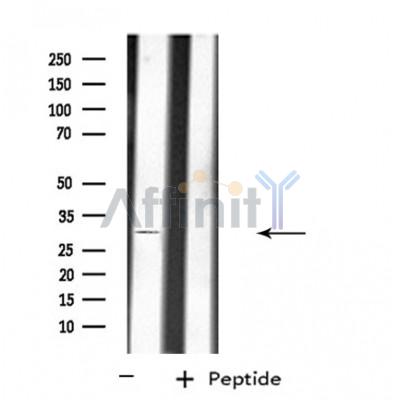ATP1B3 Antibody - #DF4528
| Product: | ATP1B3 Antibody |
| Catalog: | DF4528 |
| Description: | Rabbit polyclonal antibody to ATP1B3 |
| Application: | WB IF/ICC |
| Reactivity: | Human, Rat |
| Prediction: | Pig, Bovine, Sheep, Rabbit, Dog |
| Mol.Wt.: | 31 KD; 32kD(Calculated). |
| Uniprot: | P54709 |
| RRID: | AB_2836879 |
Related Downloads
Protocols
Product Info
*The optimal dilutions should be determined by the end user. For optimal experimental results, antibody reuse is not recommended.
*Tips:
WB: For western blot detection of denatured protein samples. IHC: For immunohistochemical detection of paraffin sections (IHC-p) or frozen sections (IHC-f) of tissue samples. IF/ICC: For immunofluorescence detection of cell samples. ELISA(peptide): For ELISA detection of antigenic peptide.
Cite Format: Affinity Biosciences Cat# DF4528, RRID:AB_2836879.
Fold/Unfold
AT1B3_HUMAN; atp1b3; ATPase Na+/K+ transporting beta 3 polypeptide; ATPB 3; ATPB-3; ATPB3; CD 298; CD298; CD298 antigen; FLJ29027; Na K ATPase beta 3 polypeptide; Na+/K+ ATPase beta 3 subunit; NKAB3S; Sodium potassium ATPase subunit beta 3 (non catalytic); Sodium pump subunit beta 3; Sodium/potassium dependent ATPase beta 3 subunit; Sodium/potassium dependent ATPase subunit beta 3; Sodium/potassium transporting ATPase beta 3 chain; Sodium/potassium transporting ATPase subunit beta 3; Sodium/potassium-dependent ATPase subunit beta-3; Sodium/potassium-transporting ATPase subunit beta-3;
Immunogens
A synthesized peptide derived from human ATP1B3, corresponding to a region within the internal amino acids.
- P54709 AT1B3_HUMAN:
- Protein BLAST With
- NCBI/
- ExPASy/
- Uniprot
MTKNEKKSLNQSLAEWKLFIYNPTTGEFLGRTAKSWGLILLFYLVFYGFLAALFSFTMWVMLQTLNDEVPKYRDQIPSPGLMVFPKPVTALEYTFSRSDPTSYAGYIEDLKKFLKPYTLEEQKNLTVCPDGALFEQKGPVYVACQFPISLLQACSGMNDPDFGYSQGNPCILVKMNRIIGLKPEGVPRIDCVSKNEDIPNVAVYPHNGMIDLKYFPYYGKKLHVGYLQPLVAVQVSFAPNNTGKEVTVECKIDGSANLKSQDDRDKFLGRVMFKITARA
Predictions
Score>80(red) has high confidence and is suggested to be used for WB detection. *The prediction model is mainly based on the alignment of immunogen sequences, the results are for reference only, not as the basis of quality assurance.
High(score>80) Medium(80>score>50) Low(score<50) No confidence
Research Backgrounds
This is the non-catalytic component of the active enzyme, which catalyzes the hydrolysis of ATP coupled with the exchange of Na(+) and K(+) ions across the plasma membrane. The exact function of the beta-3 subunit is not known.
Cell membrane>Single-pass type II membrane protein. Melanosome.
Note: Identified by mass spectrometry in melanosome fractions from stage I to stage IV.
The C-terminal lobe folds into an immunoglobulin-like domain and may mediate cell adhesion properties.
Belongs to the X(+)/potassium ATPases subunit beta family.
Research Fields
· Environmental Information Processing > Signal transduction > cGMP-PKG signaling pathway. (View pathway)
· Environmental Information Processing > Signal transduction > cAMP signaling pathway. (View pathway)
· Organismal Systems > Circulatory system > Cardiac muscle contraction. (View pathway)
· Organismal Systems > Circulatory system > Adrenergic signaling in cardiomyocytes. (View pathway)
· Organismal Systems > Endocrine system > Insulin secretion. (View pathway)
· Organismal Systems > Endocrine system > Thyroid hormone synthesis.
· Organismal Systems > Endocrine system > Thyroid hormone signaling pathway. (View pathway)
· Organismal Systems > Endocrine system > Aldosterone synthesis and secretion.
· Organismal Systems > Excretory system > Aldosterone-regulated sodium reabsorption.
· Organismal Systems > Excretory system > Endocrine and other factor-regulated calcium reabsorption.
· Organismal Systems > Excretory system > Proximal tubule bicarbonate reclamation.
· Organismal Systems > Digestive system > Salivary secretion.
· Organismal Systems > Digestive system > Gastric acid secretion.
· Organismal Systems > Digestive system > Pancreatic secretion.
· Organismal Systems > Digestive system > Carbohydrate digestion and absorption.
· Organismal Systems > Digestive system > Protein digestion and absorption.
· Organismal Systems > Digestive system > Mineral absorption.
Restrictive clause
Affinity Biosciences tests all products strictly. Citations are provided as a resource for additional applications that have not been validated by Affinity Biosciences. Please choose the appropriate format for each application and consult Materials and Methods sections for additional details about the use of any product in these publications.
For Research Use Only.
Not for use in diagnostic or therapeutic procedures. Not for resale. Not for distribution without written consent. Affinity Biosciences will not be held responsible for patent infringement or other violations that may occur with the use of our products. Affinity Biosciences, Affinity Biosciences Logo and all other trademarks are the property of Affinity Biosciences LTD.



